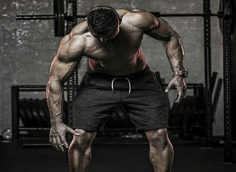Everyone wants a bigger bench press. Or at least they want to add enough plates to the bar so it's not embarrassing. Here are three exercises guaranteed to boost your bench.
This will help you forcefully drive the bar off your chest. One of the major benefits? It eliminates any stretch reflex you may get from a standard bench press.
When an eccentric/lowering contraction precedes a concentric/lifting contraction, the body is aided by stored elastic energy in the muscle. This creates a mechanical "stretch reflex" that gives you a little spring of assistance.
A stretch reflex isn't necessarily a bad thing, but gaining the ability to generate force from a dead stop will ultimately lead to better control of the weight, better muscle recruitment, and a bigger bench press.
This variation also encourages tightness through the upper back. If you don't get tight and "set" your shoulder blades, pressing a big weight from this position will be next to impossible.
Set the pins so the bar barely grazes the chest or is slightly above it.
This will help you train the top half of the bench press and develop your triceps. It's used frequently by geared powerlifters who compete in a bench shirt, but it can also be used by anyone looking to put a couple more pounds on his or her bench.
For geared powerlifters, the bench shirt stores elastic energy that gives them that spring of assistance mentioned earlier. The spring from the shirt diminishes as the bar is moved from the chest, which necessitates strong triceps to lock out the lift.
This exercise allows you to overload your bench through a limited range of motion. While most of your training should involve going through a ROM, strategically using partials allows you to train with heavier weights than normal. This will build the tensile strength of the tendons and ligaments in the hands and forearms, which will lead to the ability to stabilize more weight.
Although you'll be able to use more weight with this variation, start slowly. Dramatically increasing the weight your first couple of times will piss off your elbows. Gradually upping the weight will give your body time to adapt.
Set the pins approximately halfway to three-fourths of the way to your full arm extension.
If you can't stabilize the load, there's no way you'll be able to complete your lift successfully. Thick bar reverse curls strengthen your forearms and hands, which give you a stronger grip on the bar. Increased grip strength allows you to have better control of the weight.
Grip strength is also strongly tied to an efficient nervous system. Having a tight, powerful grip on the bar allows you to recruit more musculature. This leads to a more efficient transfer of force when driving the bar off your chest.
If you don't have a thick bar, you can always use Fat Gripz to modify the grip width on standard barbells or dumbbells.
T Nation earns from qualifying purchases as an Amazon Associate. Read more about our policy.





